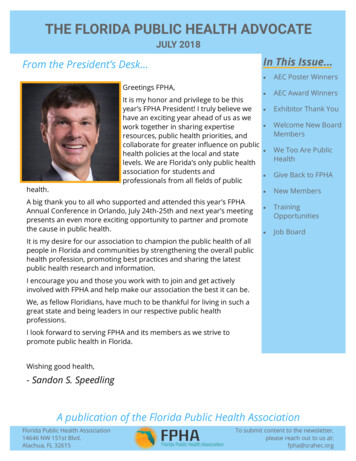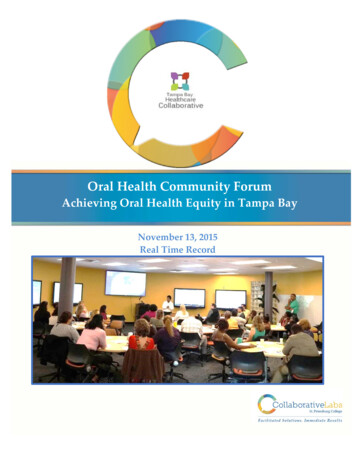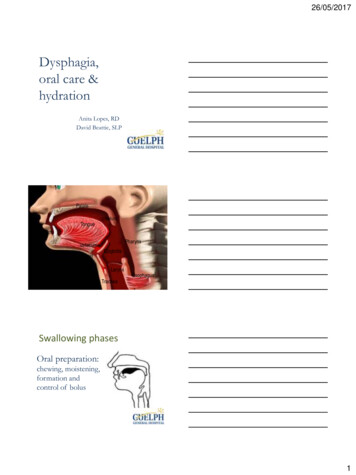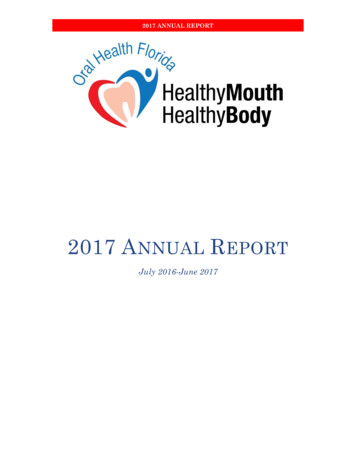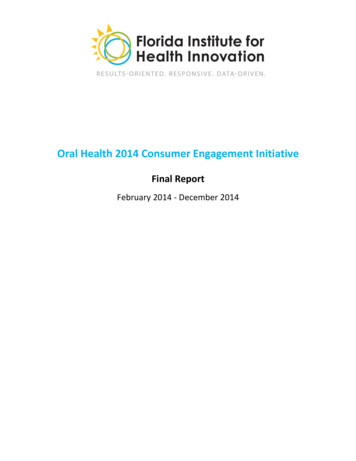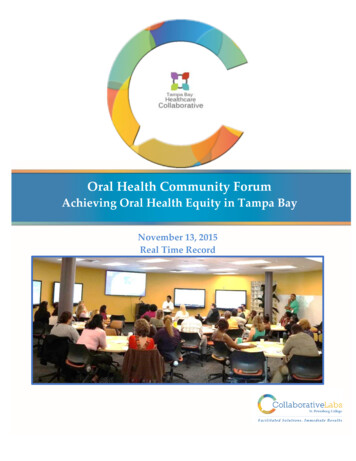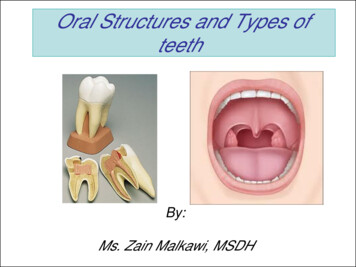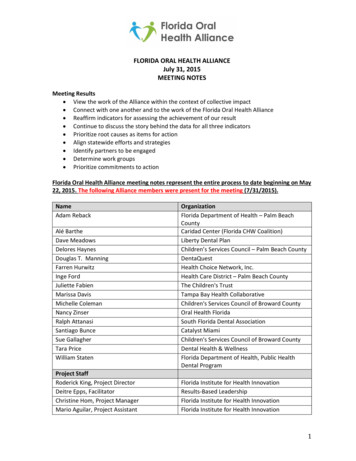
Transcription
FLORIDA ORAL HEALTH ALLIANCEJuly 31, 2015MEETING NOTESMeeting Results View the work of the Alliance within the context of collective impact Connect with one another and to the work of the Florida Oral Health Alliance Reaffirm indicators for assessing the achievement of our result Continue to discuss the story behind the data for all three indicators Prioritize root causes as items for action Align statewide efforts and strategies Identify partners to be engaged Determine work groups Prioritize commitments to actionFlorida Oral Health Alliance meeting notes represent the entire process to date beginning on May22, 2015. The following Alliance members were present for the meeting (7/31/2015).NameAdam RebackAlé BartheDave MeadowsDelores HaynesDouglas T. ManningFarren HurwitzInge FordJuliette FabienMarissa DavisMichelle ColemanNancy ZinserRalph AttanasiSantiago BunceSue GallagherTara PriceWilliam StatenProject StaffRoderick King, Project DirectorDeitre Epps, FacilitatorChristine Hom, Project ManagerMario Aguilar, Project AssistantOrganizationFlorida Department of Health – Palm BeachCountyCaridad Center (Florida CHW Coalition)Liberty Dental PlanChildren’s Services Council – Palm Beach CountyDentaQuestHealth Choice Network, Inc.Health Care District – Palm Beach CountyThe Children's TrustTampa Bay Health CollaborativeChildren's Services Council of Broward CountyOral Health FloridaSouth Florida Dental AssociationCatalyst MiamiChildren's Services Council of Broward CountyDental Health & WellnessFlorida Department of Health, Public HealthDental ProgramFlorida Institute for Health InnovationResults-Based LeadershipFlorida Institute for Health InnovationFlorida Institute for Health Innovation1
POPULATION ACCOUNTABILITYResults Statement(s): Florida Oral Health AllianceResult: All Florida children, youth and families have good oral health and well-being, especiallythose that are vulnerable.Selected Indicators:Indicators measures that help to quantify the achievement of the result.(Rated as high (H), medium (M) or low (L)CandidateCommunication Proxy PowerData PowerIndicatorsPowerPercentage ofHHHEligible MedicaidChildren Ages 0-20Receiving AnyDental ServicesNumber ofHHHpreventable ER visitswith oral healthPercentage ofHHHeligible Medicaidchildren and youththat receivedpreventative dentalservicesNumber ofNot ratedpreventable oralsurgeriesPercentage ofNot ratedcounties and/ormunicipalitieswithout fluorideprogramsNumber ofNot ratedrestorative visitsNotesCommunication Power: does this indicator communicate to a broad range of audiences? Wouldthose who pay attention to your work know what this measure means?Proxy Power: Does this indicator say something of central importance about the result? Is it a goodproxy for other indicators? Data tend to run in a “herd” – in the same direction. Pick an indicatorthat will tend to run with the herd of all the other indicators that could be used.Data Power: Is there quality data for this indicator on a timely basis? To be credible, the data mustbe consistent and reliable. Timeliness is necessary to track progress.Headline Indicators (rated as H,H,H):Of the candidate indicators you listed above, which will be your headline indicator(s)?Indicator: Percentage of Eligible Medicaid Children Ages 0-20 Receiving Any Dental ServicesData Source: Our headline indicator was taken from national and state CMS-416 form. Data forchildren ages 0-20 was retrieved for item 12a: CMS Total eligibles receiving any dental services.Data was retrieved between the years 2010-2014.2
Please note that this has been updated since our last meeting. We began by looking at ages 0-18and since revised to include ages 19 and 20. We did this in order to align with the measures thatAHCA and CMS are using. We also updated this with 2014 figures to encompass the years of 20102014.Our trend line was added for a couple of additional years (up to 2016).Data for children 0-20 years old retrieved from Florida, Louisiana, Mississippi and National CMS 416Data. Form CMS-416 is used by CMS to collect basic information on State Medicaid and CHIPprograms to assess the effectiveness of EPSDT (Early and Periodic Screening, Diagnostic andTreatment).For more information on form items: ctions.pdfIndicator: Number of preventable ER visits with oral healthData Source: Florida Pediatric Emergency Department Visits for Preventable Oral HealthConditions: 2012: 14/09/FINAL FIHI Peds ER 9.17.14.pdf3
Indicator: Percentage of eligible Medicaid children and youth that received preventative dentalservicesData Source: The data was obtained from national and state CMS-416 form. Data for children ages0-18 was retrieved for item 12a: CMS Total eligibles receiving any dental services. Data wasretrieved between the years 2009-2014. The trend line was added for a couple of additional years(up to 2016). Data for children 0-20 years old retrieved from Florida and national CMS 416 Data.Form CMS-416 is used by CMS to collect basic information on state Medicaid and CHIP programs toassess the effectiveness of EPSDT (Early and Periodic Screening, Diagnostic and Treatment). Formore information on form items: ctions.pdThese remaining indicators have not been addressed since the May 22, 2015 meeting.Indicator: Percentage of counties and/or municipalities without fluoride programsData Source: Florida Department of icators/NonVitalIndNoGrpDataViewer.aspx?cid 0286.As of July 1, 2015, 21% (14 counties) are without community water fluoridation.Indicator: Number of preventable oral surgeriesData Source: Pending SubmissionIndicator: Number of restorative visitsData Source: Pending SubmissionData Development agenda (rated as H,H,L):Are there any candidate indicators with high communication power, high proxy power but low datapower (data is not available)? This would mean that a data development agenda is needed.On July 31, 2015, the group identified the following missing data (7/31/15): CDT codes (billing codes)4
AgesOur headline indicator does not capture anything provided by non-dentist or someone notsupervised by a dentistIndividuals who volunteered to form a data work group included: Farren Hurwitz Tara Price Dave Meadows Juliette Fabien Douglas ManningNotes on missing data: Other professionals that are delivering dental services. Other non-Medicaid eligible children and youth that received dental services. Utilization and no show rates are not available. Florida shows poor results. There is a lack of understanding about the impact of dental care. There are children and youth who have access that are not receiving dental services. Reimbursement for dental services is low. A limited reimbursement system that pays for treatments but not for preventative services. No data results for lack of claim forms for free dental services.Turn the Curve Report(POPULATION)ResultAll Florida children, youth and families have good oral health and well-being, especially those thatare vulnerable.Headline INDICATORThe following information represents a culmination of work since the initial Florida Oral HealthAlliance meeting.5
Story behind the dataWhat has caused the data to increase? (Contributing factors)Contributed on July 31, 2015: Efforts on behalf of community organizations that focus on oral health School based services that provide oral care FQHC’s that focus on oral health while achieving oral health equityContributed on May 22, 2015 An increase in efforts throughout Florida to improve access to dental care Increase in awareness of the importance of oral health Grassroots efforts directed at improving oral healthWhat has caused the data to decrease? (Restricting factors)Contributed on July 31, 2015: An exclusion of certain populations, primarily undocumented population in state. Insufficient data of ER visits for basic care that did not receive preventative services. An increase of local and community initiatives but not many statewide initiatives. A limited reimbursement system that pays for treatments but not for preventative services. An ineffective and realistic oral health policy focus in the state. A lack of integration between physical medicine and oral health. An isolated approach between private providers and public collaborative efforts. A lack of follow up case management systems for patients and members, continuation ofcare, and post-op. Inadequate number of providers in care network and access points.Contributed on May 22, 2015: There is a lack of consistent collaboration and disparity from partners and stakeholders. Low or poor oral health literacy exists. Available dental services are not being accessed. There is a need to increase parental education and overall oral health literacy. There is a need to work consistently and improve the data. Payment to dentists (fees) for preventative services is low which leads to a lack of qualityproviders. Inadequate funding does not provide access to services which leads to a low number ofproviders, lack of coverage, and benefits.What are the most important root causes to address?1. Lack of parent knowledge or understanding of importance of preventative care, whichincludes nutrition, safe sleep and oral cancer.2. Low or poor oral health literacy exists and includes factors such as cultural diets, conceptsof health and value of oral health.3. There are available dental health services that are not being accessed.4. Inadequate funding does not provide access to services which leads to a low number ofproviders, lack of coverage, and benefits.5. There is a lack of consistent collaboration from partners and stakeholders, including oralhealth understanding by legislators.6
6. There is a need to increase requirements and gather “meaningful use” data across oralhealth community.What works: (known solutions)At the July 31, 2015 face to face meeting, participants identified the following strategies1. Consistent collaboration among providers, stakeholders combined with state legislators.2. (Palm Beach County, Tampa Bay) Established partner organizations with FQHC’s providingoral health.3. (Palm Beach County, Tampa Bay) Literacy and education for women with infants.4. (Miami-Dade, Broward) Continuation of funding for FQHC’s to provide free oral healthservices in schools. All successful school based services.5. (Union, Lee, Glades counties) Identification of gaps in oral health care to improve.6. Medicaid Managed Assistance (MMA) is a program with performance measures to deliverquality services.At the May 22, 2015 face to face meeting, participants identified the following three strategies asstrategies that work to turn the curve.1. Collaboration among stakeholders2. Use of best practices used by other states3. Implementation of dental programs through advocacy and educationIn response to a call for other successful strategies that work, Tara Price, (V.P., Operations)Dental Health & Wellness and Mary Weaver (Senior Health Services Analyst, Public HealthDental Program) from the Florida Department of Health provided their successful strategies.These strategies were presented at the July 1, 2015 virtual meeting: Florida Department of Health Initiatives that increase access to fluoridation using aCommunity Water Fluoridation grant and a statewide initiative to provide dental sealantsutilizing a school based program. Successful tactics from Dental Health & Wellnesso Contracting with county health departments to pay them for school based servicesand other health access settings to help promote that programo Partnering with Sunshine Health Provider Relations representatives to visitpediatrician offices and educating staff on how to view dental care gaps inSunshine’s provider web portal;o Providing the office with a list of participating dentists in their area to which theycan refer.o Holding a health and dental fair for Sunshine members in an area where we have ahigh concentration of members with care gapsWhat is our STRATEGIC plan with our ROLE, to improve the data?Strategies for ActionDuring the July 31 meeting, participants selected the proposed and applied the following fourcriteria to each of the options: leverage, feasibility (or reach), specificity, and values.1. Florida Oral Health Alliance will develop, along with AHCA, to standardize data collectionand create “meaningful use” requirements.2. To convene health plans with community organizations and partners to meet HEDISmeasure as it applies to oral health.3. Create Google form to document Florida Oral Health Alliance partners.4. Secure funding and other opportunities (i.e. Kickstarter) to fund mandates.5. Utilize technology for quality outcomes7
During the July 1 meeting, multiple oral health action plans that exist throughout the state werefeatured. This included: The Agency for Healthcare Administration (AHCA) presented their State Oral Health ActionPlan (SOHAP). This plan can be accessed by request by contacting Robert Reifinger, (Dental& Child Health Check-up, Primary and Preventive Care Policy,Robert.Reifinger@ahca.myflorida.com). Also presented during the meeting were the Florida Dental Association’s Action for DentalHealth statewide plan to promote attainable dental care for the uninsured andunderserved in Florida. This included:o FDA to collaborate to maximize use and capacity of the current dental workforce tooptimally serve Floridians with preventive and therapeutic dental care.o FDA will expand opportunities for public health dentistry to serve Floridians. Oral Health Florida’s Roadmap for Oral Health addresses several areas for oral healthimprovement including building partnerships and utilizing Roadmap strategies for futuresuccess. Oral Health Florida gave an overview of its current plans and work groups. Formore information: www.oralhealthflorida.org.The following strategies were designed through a small group activity at the face to face meetingon May 22, 2015 and during the face to face Florida Oral Health Alliance meeting on July 31, 2015in West Palm Beach, Florida.The information below is a cumulative report of strategies by Alliance participants since May 22through July 31.To further engage local and state wide partners, such as legislators, school board, as well as SpecialOlympics Florida.Factor/ Cause*An increase inFlorida toimprove accessto dental care. STRATEGYConsistent collaboration betweenoral health providers, stakeholdersand legislators. Partner(s)School boardsSchool nursesCommunity centersState basededucation campaign8
Payment todentists (fees)for preventativeservices is lowwhich leads to alack of qualityproviders.Lack ofunderstanding ofMedicaid dentalinsuranceFearLow or poor oralhealth literacyexists. Engage legislators and advocates tosupport governmental program toinclude expansion of Medicaid.Increase the number ofparticipating providers includingnon-dental.Implement best practices used inother states to increaseparticipation in Medicaid programsImprove dentist payments forpreventative services Increase outreach and networkdevelopment Promote increased participation ofdental providers in managed careprograms to improve access to care Increase number of providers toreduce costs and improvereimbursements Align with hospitals (whole healthcare) that integrate dental care Educate legislature on importanceof dental care and reimbursement Health plans need to takeadvantage of payment (rate) Provide flexibility to pay dentistsmore for preventative care Demonstrate improved outcomes Increase state funding Increase a number of providers toimprove access and reduce costsand improve reimbursements.Strategies were not identified during themeeting. Increase parent knowledge Lack of parent knowledge orunderstanding of importance ofpreventative care A lack of knowledge of communitydental resources exists. Increase Alliance media andcommunication tools forparticipants. Create local “champions” to provideinformation and infuse value of oralhealth, through schools, faith andcommunity based organizations. – through publichealthParentsPediatriciansFaith ofessionalassociationsWICAHCAManaged care dentalplansLegislatureFaith basedcommunitiesSocial servicesCSC’sDepartments ofHealthPublic schoolsHealth plansAHCADCFMediKidsNavigatorsFlorida Action forDental Health Dentists and dentalsocieties School Districts Consumer Advocates WIC services Oral Health CoalitionPalm Beach County School Based OralHealth (Miami-Dade,CSC-Broward) Oral Health Equity(Tampa Bay HealthInitiative)9
Next Steps: What do we propose to do to turn the curve?On July 31, 2015, as a next step in order to maintain continuous communication, group discussedthe following communication vehicles: Google forum Wiki DQF BasecampThe group identified additional partners to be engaged Florida Agency for Health Care Administration Florida Department of Education Human services providers (social services) Oral health consumers to tell their stories and participate on Alliance work committees*List the priority root causes to be addressedThis has not yet been defined by the group.10
Jul 31, 2015 · Adam Reback Florida Department of Health – Palm Beach County Alé Barthe Caridad Center (Florida CHW Coalition) Dave Meadows Liberty Dental Plan Delores Haynes Children’s Services Council – Palm Beach County Douglas T. Manning DentaQuest Farren Hurwitz Health Choice Network, Inc


